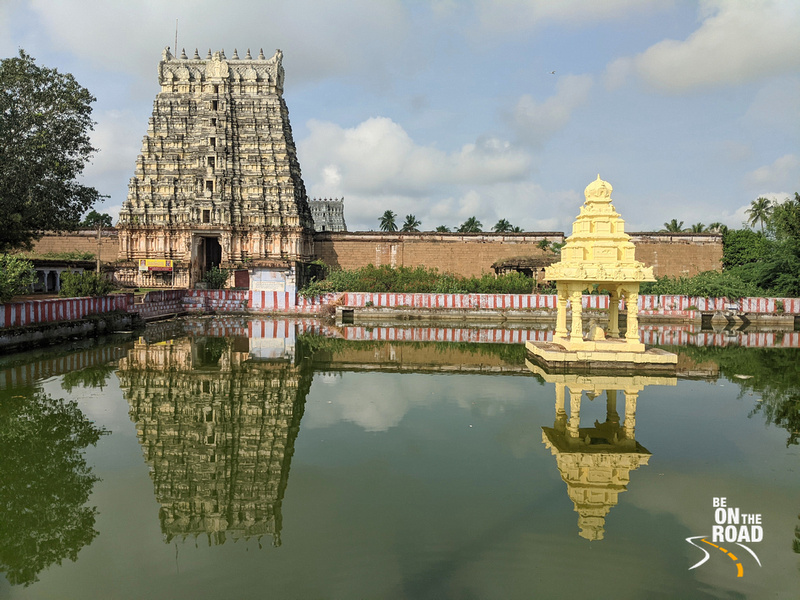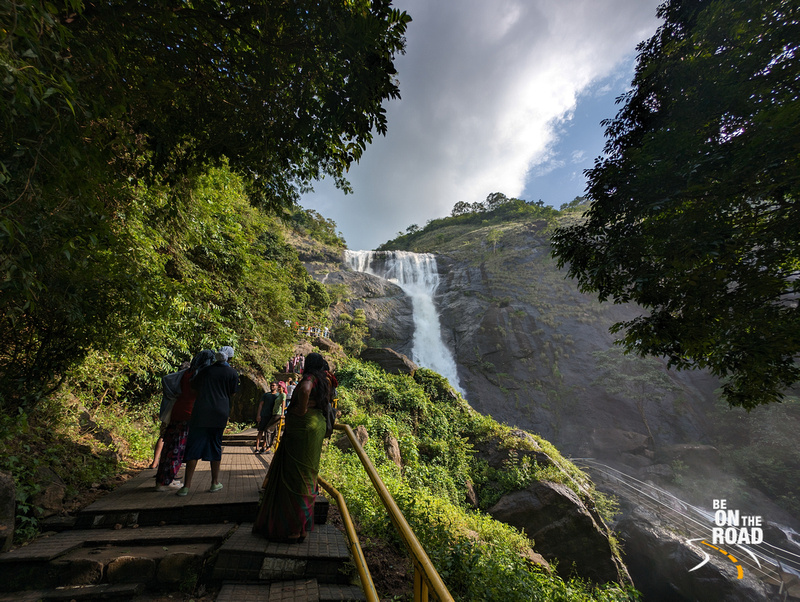10th Century Brahmadesam Kailasanathar Temple: Lesser Known Architectural Marvel of South India

It is one of the largest temples of its time with three gopurams and seven vimanas. The theme of this temple seems to be on size like the Brihadeeswarar temple at Thanjavur. It is home to a swayambhu lingam that is one of the three swayambhu lingams along the Gadananathi river (the other two being the Sivasailam temple and the Valiswara temple at Thiruvaliswaram). It is one of the shrines of the Vaippu sthalams sung by Tamil Saivite Nayanar Appar. It is considered as the oldest amongst the ‘Nava Kailayam” temples and it is also a Navagraha Sthalam of Surya Deva. It is a prarthana sthalam for those seeking to do well in education. It was built by the Cholas and key additions were made by the Cheras, Pandyas, Hoysalas and Nayakas. Lord Brahma and his grandson Romasa Maharishi worshipped Lord Shiva here. I am talking about the 10th century Kailasanathar temple at Brahmadesam in the Tirunelveli district of Tamil Nadu.
The Kailasanathar temple at Brahmadesam was originally built in the 10th century under the reign of Raja Raja Chola I. During the reign of Raja Raja Chola I, this village was donated for Vedic scholars for chanting the four Vedas and hence named as Chaturveda Mangalam or Brahmadhayam. The original temple, including the sanctum, ardhamandapa and mukhamandapa were built by the Cholas. The Pandya kings built a few more mandapas. The intricate wooden decors at the roof of the mandapa and the wooden doors at the entrance were carried out by the Chera kings. The seven storied Rajagopuram in the front, the five storied gopuram at the back and the compound wall were constructed by King Viswanatha Nayaka, who ruled from Tirunelveli. Hoysala kings also made some structural additions to this shrine. There is a vantage point (that is marked) inside the temple where all the gopurams and vimanas can be seen together. This is where you will be awed at the gargantuan size of this temple. No travel site or travel guide talks about this temple. This magnificent masterpiece is definitely one of the best temple destinations in South India.

The Kailasanathar temple is rich in sculptural wealth. It is home to five Shiva lingams with separate sanctum sanctorum in the temple. They are:
1) Kailasanathar
2) Badari Vaneswarar
3) Viswanathar with Visalakshi

4) Arunachaleswarar with Unnamalai
5) Sundareswarar with Meenakshi
Goddess Brihannayaki or Periya Nayaki is extremely beautiful. She is in a standing posture with a a lotus in her right hand. There is a unique sannadhi for Lord Gangalanathar standing seven feet tall where he has a Jata Mukuta (hair dressed like a crown) and big ear rings. He has four arms. He carries a drum (dhakka) in his left lower arm and he beats the drum with a stick (bana) with his lower right arm. His upper right arm is stretched downwards in the Kataka (crab) posture and his upper left arm has a kankala danda, a staff that carries the bone of the arms and legs of the slain person. The staff if resting on his left shoulder.

Nandikeshwarar, Natarajar (Punuku Sabhapati), Athma Vyakya Dakshinamoorthy with the chin mudra facing his own self and Jwahara Deva are certain examples of the iconographic treasures of this temple. The Pradosha sabhai with Pradosha murthy, Ashta Dik Balakas with their respective vimanas, Siva Bhoothaganas and apsaras belong to a very rare specimen of deities. Chandikeshwari, Saraswati and Uchchistha Ganapati are seen in the prakara of goddess Brahannayaki’s shrine.

The Arudra mandapam is an example of architectural excellence. The entire area is full of wide pillars with sculptures. A unique feature of these pillars is that there are six pillars placed together to form a single pillar. The Dharma Nandi is an intricately carved monolith of large size. It stands seven feet tall and sports anklets and other jewellery. This nandi located at the entrance is the largest in the district of Tirunelveli and is surprisingly distinctive with its brilliant carvings. Balipeetha and dwajasthamba on carved platform are also of huge size. There is a beautiful bell with three chain links sculpted from a single stone is suspended from the roof. This is a special work of art in this temple. Another special work of art in this temple is an astonishing lion statue in the temple walls where a round stone is found in the mouth of the lion. This stone can be rotated freely, but cannot be removed from the mouth. Another testament of remarkable craftmanship in this temple.

There are separate sannadhis for Vigneswara, Subramanya, Dharma Saastha, Bala Murugan, Surya, Chandra, Dakshinamoorthy, Navukkarasar, Appar and Sundarar. The Somavara mandapam is another masterpiece of sculptors of that age. It is full of pillars with many beautiful sculptures and carvings. Some important sculptures include Bheema, Purushamrigham, Arjuna, Karna, Vali, Sugreeva, Rati and Manmadan.

A large and prominent temple pond invite the devotees from outside the temple tower. The devotees and connoisseurs of temple art and architecture will enter into the temple through the east facing massive seven tier Chola style rajagopuram (brick and wooden structure) profusely adorned with stucco images. The extremely tall wooden main doors at the Rajagopuram entrance with intricately carved panels let in the connoisseurs to the surreal world of gorgeous architecture and iconography.

There is an aesthetically designed long pillared mandapam called Tiruvadarai Mandapam between the rajagopuram and the main sanctum. This mandapam is supported by 10 square-based pillars and two non-figural cluster pillars carved with 12 lion brackets and 12 drop brackets. The pillar faces also contain bas reliefs. The roof of the pillared mandapam showcases the Kerala wooden roof architecture, but it is sculpted in stone. It has a shrine dedicated to the stone images of Natarajar and Sivagami. This hall has many beautiful sculptures and intricate carvings on the pillars that depict various gods, goddesses, seers, epic characters, mythological animals such as yazhis, elephants, dance, music, battle and even erotic.

This lesser known architectural marvel of South India should be a must-visit if you are a temple lover and if you wish to visit the great temples of South India. Lets appreciate the beauty of the Brahmadesam Kailasanathar temple and share our experiences with others. Hopefully, more people will visit this temple and the government will take action and stop neglecting this historical gem of a temple. This is one of Tirunelveli’s top tourist attractions and one of the best temples South India with more than 1000 years of heritage and stories. I cannot stop recommending this temple enough.

Famous festivals of this temple:
Maha Shivaratri, Aarudra Dharshanam, Panguni Uthiram (when swamy comes out in a silver Vrishabha vahanam), Aippasi Uthiram (celebrating the marriage of Kailasanathar and Brihannayagi in a grand manner), Thiruvathirai and Makara Sankranti are the major annual festivals celebrated here. Every month, the two Pradosham days hold particular significance at this temple.

How to reach there:
The nearest railway and bus station is Ambasamudram, located about 5 kms away. From Ambasamudram, take the road leading towards Ambai Arts College, Gowthamapuri and then into Brahmadesam village. Once you reach Brahmadesam, you can spot the temple gopuram, but it might be tough to find the road that leads to the main entrance. It is best to ask locals or check Google maps. After weaving through tiny lanes of Brahmadesam village agraharam, you will reach the main entrance of the Kailasanathar temple at Brahmadesam and the large temple pond next to it.
The nearest airport is Tuticorin, located about 80 kms away.

Best season to visit:
The Kailasanathar temple at Brahmadesam is open all year round. However, it can get quite warm during the summer months between March and June. Even during the other months, it is best to visit the temple in the early hours of the morning or during the evening hours so that you can walk barefoot on the granite stone floor of the temple. The months from October to February are pleasant and offer lush views in the countryside surrounding the temple.

Temple timings:
The temple is open every day of the year from 5:30 AM to 10:30 AM and from 5:30 PM to 8:00 PM. Timings can get preponed during some months such as Margazhi (December 15 to January 15).

Where to stay:
The nearest place with decent hotels would be Ambasamudram. Hotel Ambai Grand is the best option here.
If you wish for luxury, I would recommend trying the hotels at Tirunelveli – GRT Regency, Jankiram and/or Aryas.
If you wish to stay in slightly cooler weather, you should try the resorts in and around Courtallam.
If you wish to stay amidst pristine nature, I would recommend that you stay at the forest rest houses in Kalakad Mundanthurai Tiger Reserve.
If you care for a true rustic experience, I would recommend that you stay at any of the home stays or guest houses in Kallidaikurichi village agraharam.

Where to eat:
You can find some basic snacks with tea/coffee in the village of Brahmadesam. For elaborate food options, I would recommend that you either head to Hotel Ramanas or Hotel Gowri Shankar at Ambasamudram. Both of them serve delicious vegetarian tiffin items and meals at reasonable prices.

Other nearby tourist attractions:
1) Mannarkoil Rajagopalaswamy Temple: magnificent 10th century temple with an ashtanga vimana
2) 1000 year old Papanasanathar temple at Papanasam: Where you can wash all your sins away
3) Sivasailam temple: 1000 year old temple surrounded by the lush mountains of the Western Ghats
4) Sivasailam: One of the wettest places during the North East Monsoon in India

5) Kallidaikurichi: The village of the saaral season
6) Iruttu Kadai Halwa: Icon of Tirunelveli
7) Nellaiappar Temple: A 7th century cosmic dance wonder
8) Pattamadai Pai: GI tagged beautiful hand woven mats from a tiny Tamil Nadu village
9) Thamirabharani river delta: A motorcycle route full of rustic gorgeousness
10) 10th century Valisvara temple at Thiruvaliswaram: Hidden Chola gem in the Tirunelveli district of Tamil Nadu
11) Karaiyar Dam: Offbeat wildlife and nature holiday destination in India’s deep South
12) The hidden gem called Kalakad Mundanthurai Tiger Reserve

13) Courtallam: The herbal bath holiday destination of Tamil Nadu
14) Tiruchendur Murugan Temple: Sea Shore Magic
15) Kallidaikurichi to Manimuthar Dam: A top scenic and rustic cycling route
16) Garuda Sevai from the agraharams of Kallidaikurichi

17) The festival of Karthigai Deepam from a traditional Tamil Nadu village
18) Cycling through the backyards of Kalakad Mundanthurai Tiger Reserve
19) 13th century Kasi Visvanathar temple at Tenkasi
20) Punalur Suspension Bridge: Historical gem of Kerala

21) Lesser known Kerala Mountain Railways: Treat for nature lovers
22) Thenmala Forest: Offbeat nature and wildlife getaway
23) Kalakad Mundanthurai Tiger Reserve: Gorgeousness Overloaded
24) Aryankavu Saastha Temple: Ancient temple located in the sacred forests of the Western Ghats

25) Palaruvi Falls: Kerala’s herbal waterfall that drops like milk from the sky
26) Oothu: The quaint little hill station of Tamil Nadu
27) Kakkachi: The highest point inside Kalakad Mundanthurai Tiger Reserve
28) Festival of Thiruvathirai from a traditional Tamil Nadu village

29) Scenic Iron Bridge of Kalakad Mundanthurai Tiger Reserve: Pristine nature overloaded
30) Manimuthar Falls: The herbal waterfall inside a tiger reserve
31) Vintage Pathimoonu Kannara Bridge: Colonial charm of the Indian Railways
32) Thenmala Dam: A monsoon pit stop

33) The exotic tropical fruits of Puliyarai
34) Kallidaikurichi Adi Varaha temple chariot festival: Grand cultural spectacle in rural Tamil Nadu
35) Kallidaikurichi Anaicut: Gorgeous picnic spot nestled in the lap of nature
36) Agastyar Falls: A gorgeous waterfall on the Thamirabhrani river
37) Manjolai: The offbeat hill station of Tamil Nadu
38) Kudrevetty: The remote and windy hill station of Tamil Nadu
39) Nalumukku: The wettest place of India during the North East Monsoon





























































